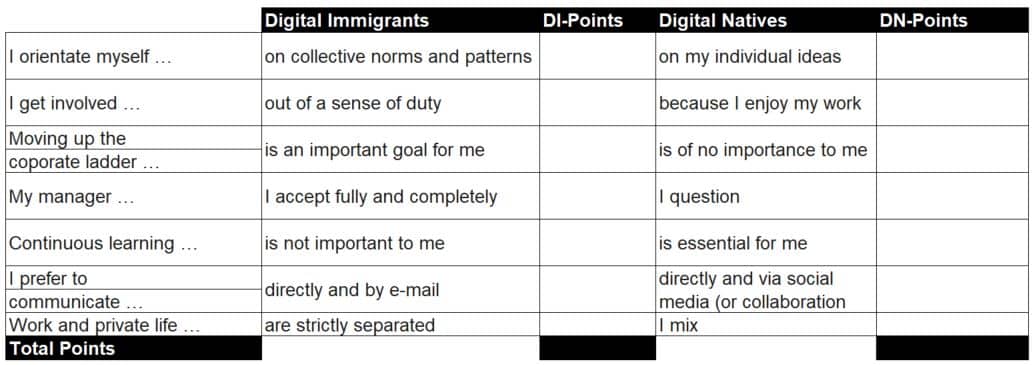Welcome, Digital Natives
Again and again you have asked for the reinforcement of your overworked project team. Imagine that: Today is the day. Two newcomers stand in front of you – Lisa with a bold ponytail and slit jeans and Tobias with baseball cap and earring, both fresh from university. As you shake hands, you sway between joy and slight uneasiness. You ask yourself: How do I best deal with them? Because you’ve often heard that the so-called “digital natives” tick completely differently than the long-term employees. But is this true?
Digital Natives – a keyword is invented
Who are the digital natives anyway?
This term was invented by the American educational consultant Marc Prensky after the turn of the millennium. At that time, the performance of American students was steadily declining. Prensky saw the reason for this in the fact that traditional knowledge transfer no longer suited the thinking of young people who grew up with digital technologies.1
Later on, it was determined quite arbitrarily: Digital natives are those born after 1980. Thus they roughly correspond to generations Y and Z, as distinguished by sociologists.
Opposite them are the “digital immigrants” – born before 1980 and thus belonging to generation X and baby boomers.
This strict distinction is questionable because it sorts people into two drawers, regardless of their real competences and values. Moreover, it is hardly supported empirically. Several recent studies found only minor differences between employees of different generations – in some cases even in unexpected directions. For example, the fact that today it is mainly young people who are looking for meaning in work has proved to be a myth.2
Nevertheless, the handy term “digital natives” spread rapidly. First in the media, then also in management literature. Thus it moved into human resources departments, which are increasingly looking for skilled workers and are courting digital natives in particular.
How the Digital Natives see themselves
The young entrepreneur Alex T. Steffen describes how he and his friends enjoy working:3
- meaningful and co-determining
- customer-oriented instead of process-oriented
- flexible, freedom-loving and experience-orientedNet
- worked and collaborative – using technologies and with the aim of sharing
Many digital natives love fairness, a sense of “we” and community and cooperation in self-organised teams. They have little regard for competition. They quickly absorb digital innovations into their lives. It is particularly important to them to receive frequent and clear feedback. After all, they are used to these short reaction times from the social media. They are also happy to give feedback themselves – directly or on platforms such as the employer rating portal Kununu.
By the way, this self-description of a digital native does not apply to all young people of his generation, but above all to young university and technical college graduates of sought-after directions.
Digital Natives, Digital Immigrants: What makes them different, what unites them
Digital natives and digital immigrants are often attributed different attitudes to work:4
- Motive for high work commitment: While digital immigrants get involved primarily out of a sense of duty, digital natives are motivated by the joy of work.
- Career: While digital immigrants tend to be attracted by career advancement in the hierarchy, digital natives tend to have a “soft career”, which includes horizontal changes and time out.
- Education: While digital immigrants rely on the lifelong reach of studies or completed vocational training, digital natives focus on lifelong learning.
Other differences concern orientation to collective or individual patterns, attitudes towards hierarchies and authorities, communication, work-life balance and job security.
Are you now frowning and wondering whether this is true in every case? You are right, because the group differences mentioned above only describe tendencies – averaged over many people from two groups. They say little about the individual.
Incidentally, both younger and older people share important values and expectations of good work: everyone wants transparency, openness and appreciation in equal measure.5 As a manager or experienced professional, orient your communication above all towards this – regardless of whether you are talking to digital natives or digital immigrants.
Test: How do you tick?
I invite you to a little self-test. Do you rather tick like a digital native, or like a digital immigrant?
For each line of the following table, please assign a total of five points, which you distribute to both empty columns – depending on how strongly the respective statement applies (0 points not at all, 5 points: completely).
Example (line 1): If you are predominantly oriented towards collective norms and only rarely towards your individual ideas, enter “4” under DI points and “1” under DN points. The sum of all points per line is 5, which means that you award a total of 40 points.
Evaluation:
Is the sum of your DI points higher than the sum of your DN points? Then you are ticking more like a “typical digital native”. Otherwise you are more like a “typical digital immigrant”. If both sums are around the average of 20, you have mixed preferences. And all this has little to nothing to do with your year of birth.
How do you like what you see? Where would you like to change a little bit?
How to deal with the Digital Natives in a relaxed manner
So do not put a stamp on the forehead of your young employees; rather ask their opinion. Where can a process be simplified, how can meetings be made more creative? Here, we can take inspiration from the digital natives, because they look at the company with a fresh view of what’s going on.
So if someone says, “That’s not going to work for us” or “That’s what we’ve always done”, it’s a good idea to bring in digital natives. In doing so, you treat yourself and your team to an unusual luxury: Critically dealing with traditional but no longer helpful ways of thinking and behaving. Removing” the old.
In addition, many digital natives have learned networked methods of collaboration. If, for example, a digital collaboration tool such as Slack or Teams is to be introduced in a project, simply let your young colleague support you in this.
Important: Make sure you give your young employees feedback promptly and frequently. How would it be if you yourself asked for feedback? Let yourself be surprised!
As a seasoned executive or professional, you might even want to support a digital native with your experience and knowledge and at the same time be inspired by their fresh view and expertise. An effective method for this is mentoring, combined with reverse mentoring. While conventional mentoring is about knowledge transfer from mentor to mentee, reverse mentoring is the other way around. Why not use these two ways couple?
Back to Lisa and Tobias, your hypothetical new employees from the beginning. Maybe one day you’ll invite them for a beer or an aperitif. Ask them what is important to them and what they dream of. If you like, you too can talk about what’s on your mind – at eye level. If you are really interested, something magical can happen: You’ll really get to know the young people, beyond the clichés. And maybe the exact same thing happens the other way round.
Summary
- “Digital Natives” and “Digital Immigrants” are vague terms. They say little about the motives, abilities and behaviour of individuals.
- Rely on the common foundation of values transparency, openness and appreciation to motivate all team members. What else is important to your young employees is best asked.
- Many digital natives are flexible, well networked, digitally fit and eager to experiment. As an experienced professional, approach them with an open mind and let them inspire you.
- In return, make your rich practical experience, your social and professional skills available. If you like, offer mentoring.
- Above all: Provide timely, frequent and appreciative feedback. It works wonders – not only for digital natives.
Notes:
This blog post is based on a chapter from the new book Willkommen in der Welt der Digital Natives: Wie Sie als erfahrene Arbeitskraft Ihre Stärken ausspielen (“Welcome to the World of Digital Natives: How to play to your strengths as an experienced worker”) by Dr. Christine Radomsky.
[1] Prensky, Marc (2001). Digital Natives, Digital Immigrants. Retrieved 27 February 2020, from www.marcprensky.com/writing/Prensky – Digital Natives, Digital Immigrants – Part1.pdf
[2] LinkedIn. (2016). Purpose at Work: Global Report. Retrieved March 2, 2019, from business.linkedin.com/content/dam/me/business/en-us/talent-solutions/resources/pdfs/purpose-at-work-global-report.pdf
[3] Schüller, A. M., & Steffen, A. T. (2017). Fit für die Next Economy: Zukunftsfähig mit den Digital Natives (1. Auflage). Weinheim: Wiley-VCH Verlag
[4] Rump, J., & Eilers, S. (2015). Das Miteinander der Generationen am Arbeitsplatz. Informationsdienst Altersfragen, 42(1), 10–18
[5] Klös, Jans-Peter et al. (2016). Die neue Generation. Retrieved May 4, 2019, from www.romanherzoginstitut.de/publikationen/detail/die-neue-generation.html
[6] Radomsky, Christine (2019). Willkommen in der Welt der Digital Natives: Wie Sie als erfahrene Arbeitskraft Ihre Stärken ausspielen. München: Redline Verlag
Photo credits Dr. Christine Radomsky: Anette Hammer, Freistil Fotografie

Dr. Christine Radomsky
Dr. Christine Radomsky is an IT engineer, holds a doctorate in physics and is a career coach. For many years she led teams of software development and validation in telecommunication and railway technology companies. In tandem with a French colleague, she managed international projects in software engineering. Today, she supports professionally experienced technical and management professionals with coaching and online courses to reorient themselves professionally in the digital change of the working world.
Her book “Willkommen in der Welt der Digital Natives: Wie Sie als erfahrene Arbeitskraft Ihre Stärken ausspielen” (“Welcome to the World of Digital Natives: How to play to your strengths as an experienced worker”) was published by Redline Verlag in November 2019.
